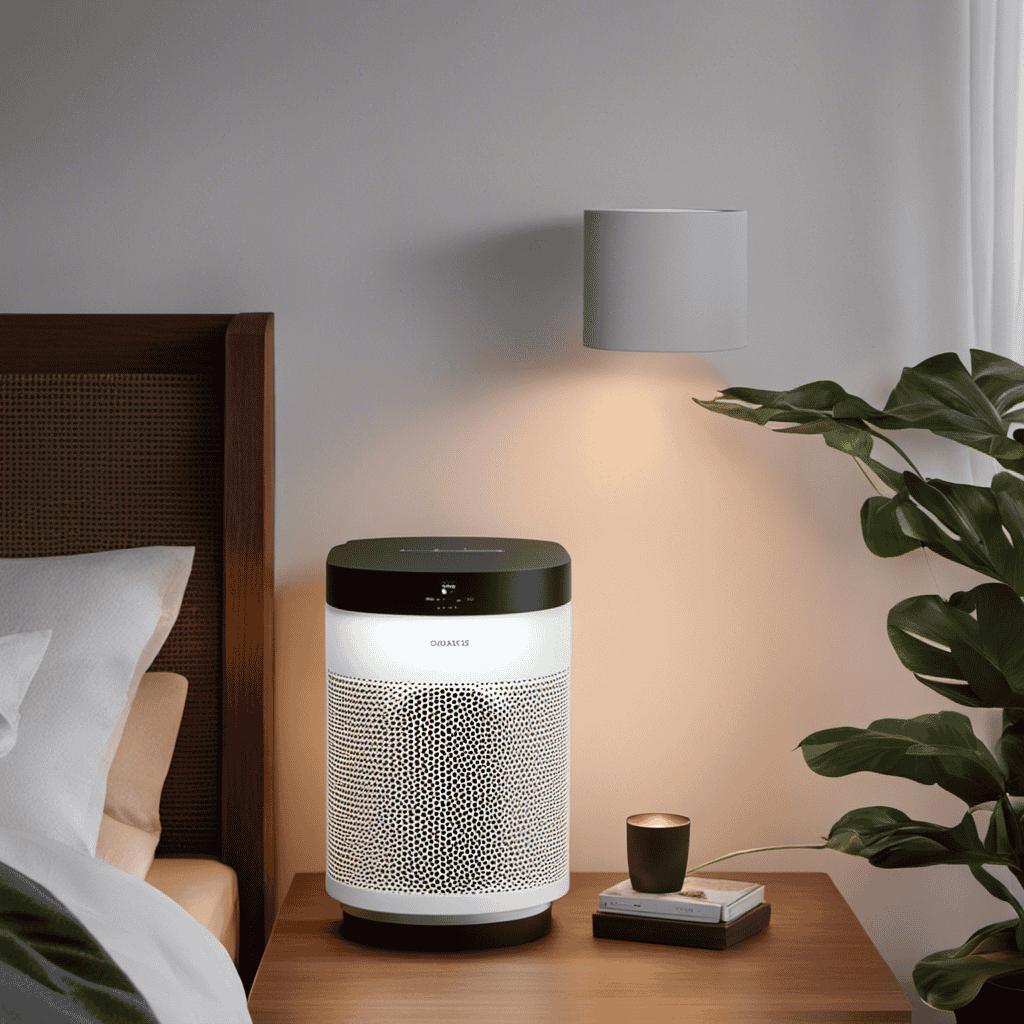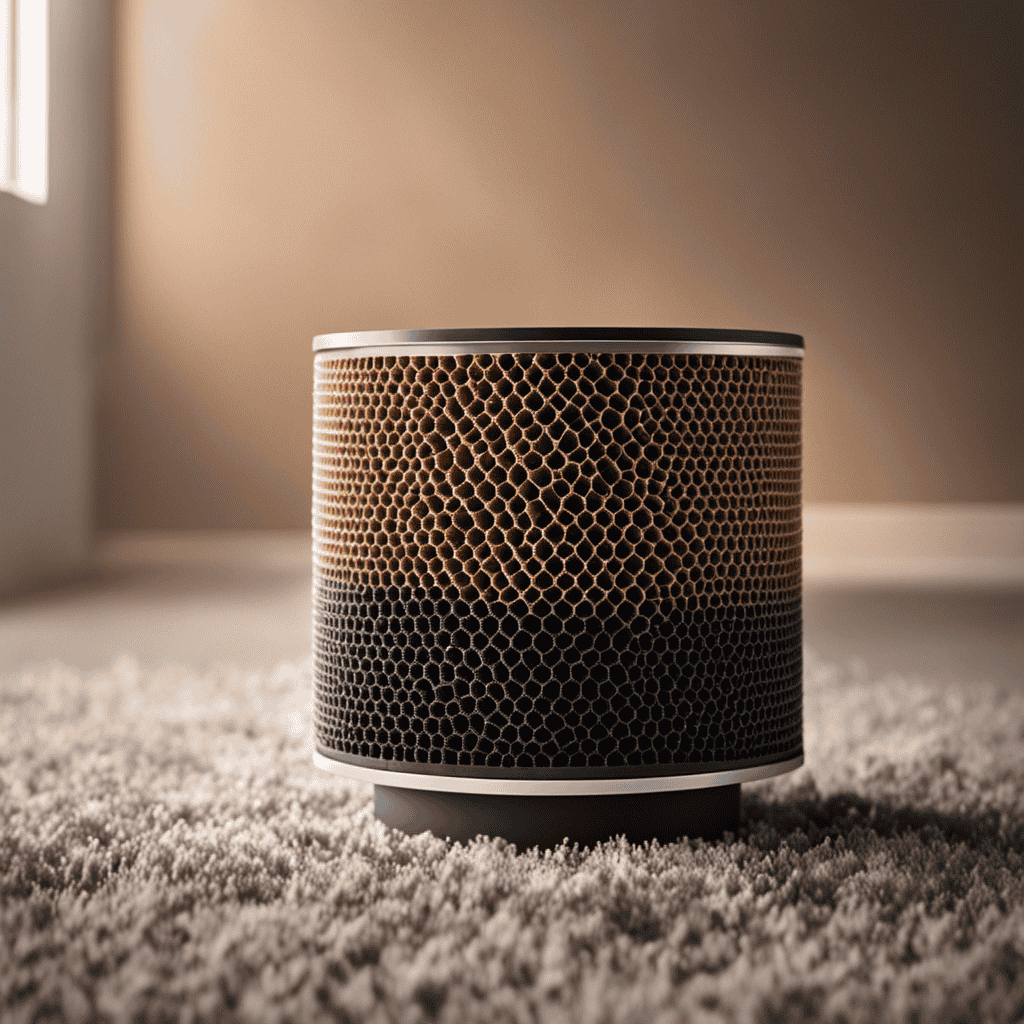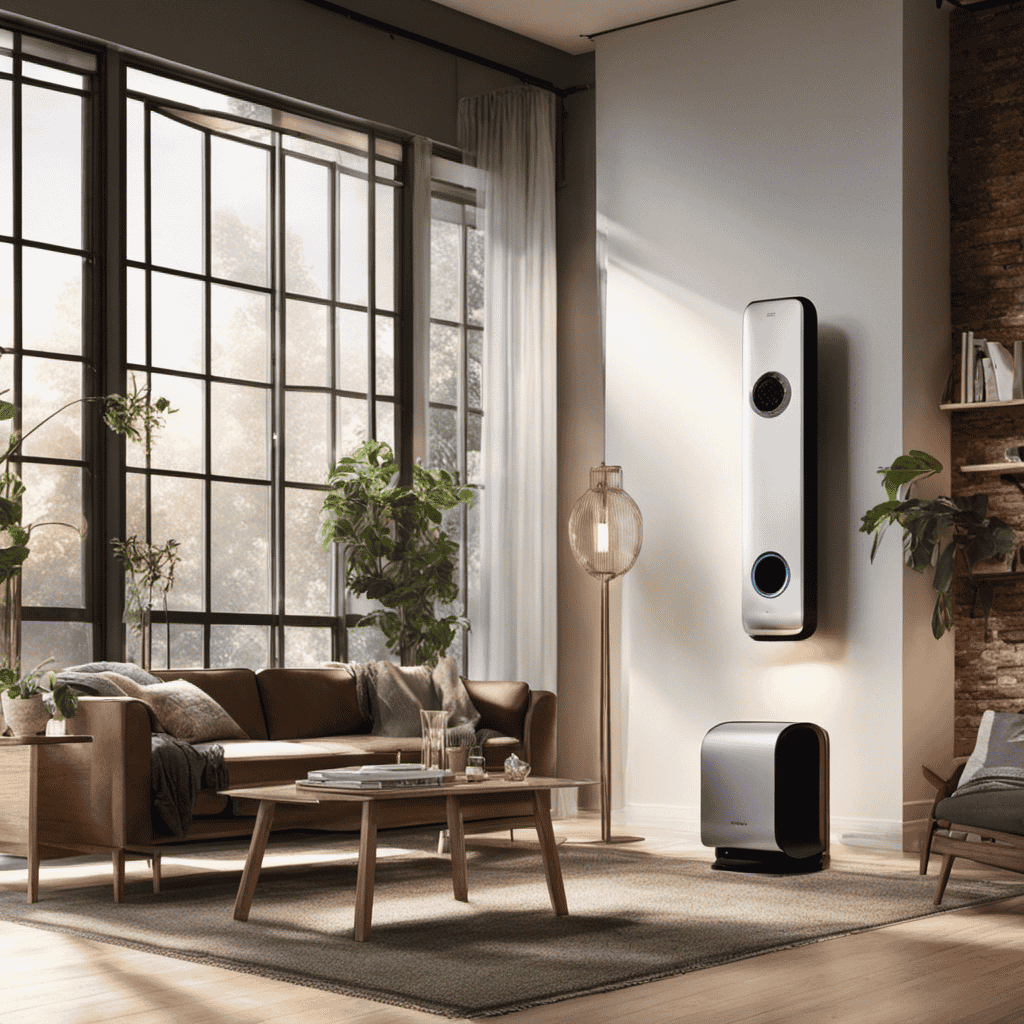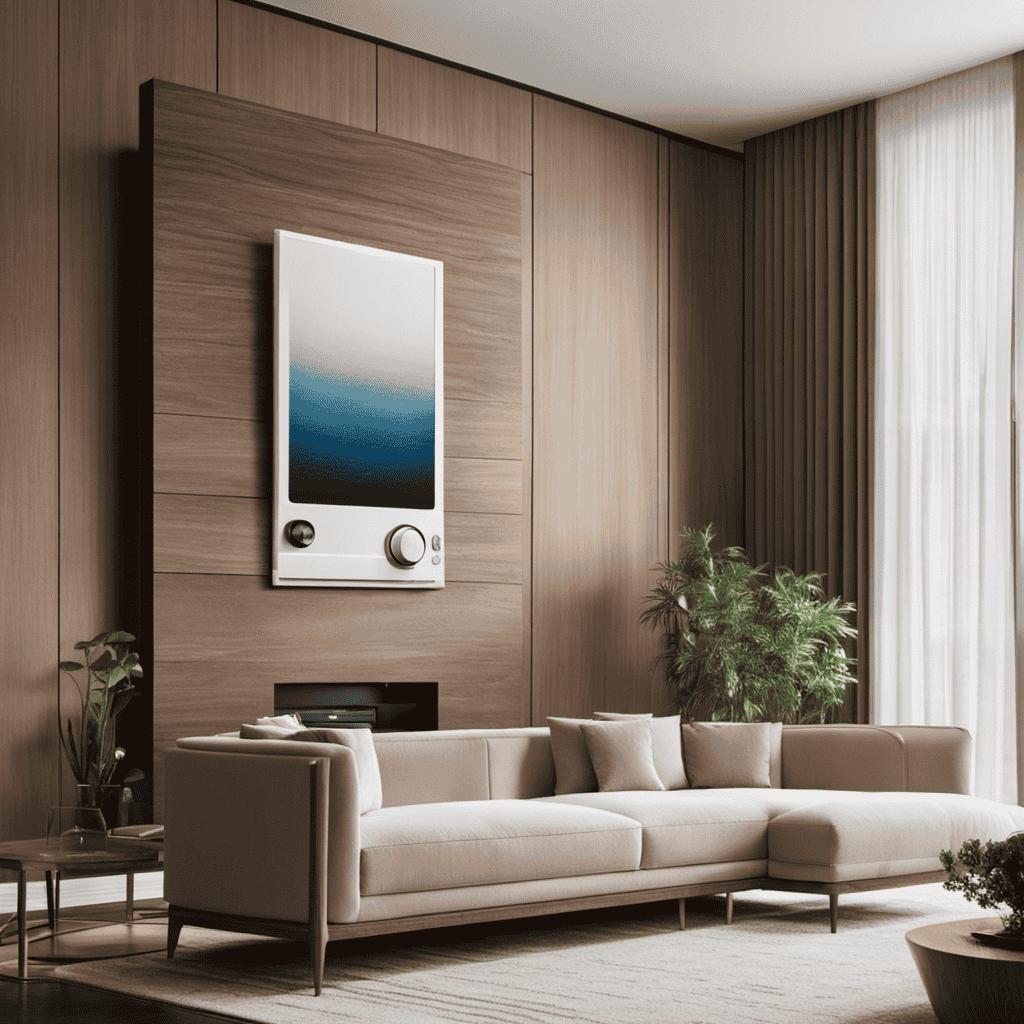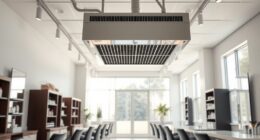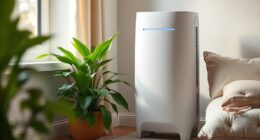As a conscientious caretaker, I’ve pondered, ‘What is the best length of time to keep my air purifier running?’ As I explored further, I learned about the significance of consistent usage and the aspects that influence the ideal timeframe. In this post, I will present you with research-backed information on suggested minimum operating periods, the effects of varying settings, and factors to keep in mind for allergies, mold prevention, and saving energy. By the conclusion, you will be equipped with the understanding to enhance the efficiency of your air purifier and enjoy fresher air with assurance.
Key Takeaways
- Continuous usage of an air purifier improves air quality and reduces the risk of allergies and respiratory issues.
- The duration of air purifier operation depends on factors such as room size, current air quality level, and personal health conditions.
- It is recommended to run an air purifier continuously in high pollen or dusty areas, while a few hours a day is sufficient in less polluted environments.
- Regular maintenance and filter replacement are essential for optimal performance and to ensure effective air cleaning.
The Importance of Leaving an Air Purifier On
It’s important to leave an air purifier on to ensure continuous filtration of the air. Personal habits, such as cooking, cleaning, and even breathing, can introduce pollutants into the indoor environment. These pollutants include dust, pet dander, pollen, and volatile organic compounds (VOCs) that can have a negative impact on our health.
By running the air purifier constantly, it can effectively remove these contaminants, improving the air quality and reducing the risk of allergies or respiratory issues.
Additionally, leaving the air purifier on can have a positive environmental impact. Rather than relying solely on opening windows or using fans, which may let in more outdoor pollutants, an air purifier can filter the air without compromising energy efficiency.
Considering these factors, it is crucial to understand the factors that determine air purifier usage duration.
Factors to Consider When Determining Air Purifier Usage Duration
When determining the duration of air purifier usage, there are several factors to consider.
Firstly, the impact of room size on air purification is crucial. A larger room may require a longer duration of air purifier operation to effectively clean the air.
Secondly, the current air quality level plays a significant role in determining the usage duration. If the air quality is particularly poor, the air purifier may need to be left on for an extended period to achieve desired results.
Lastly, personal health conditions should be taken into account. Individuals with respiratory issues or allergies may benefit from longer air purifier usage to maintain a clean and healthy environment.
Room Size Impact
The size of the room really does affect how long you should keep the air purifier on.
When it comes to air purifier placement, it is important to consider the dimensions of the room.
A larger room will require the air purifier to run for a longer period of time in order to effectively clean the air. This is because a larger space will have more air to circulate and filter.
On the other hand, a smaller room may not require the air purifier to be on for as long, as the air can be filtered more quickly.
Additionally, the noise level of the air purifier should be taken into account. If the noise level is bothersome, it may be necessary to turn off the air purifier during periods when the room is not in use.
Air Quality Level
To effectively clean the air, you’ll want to consider the current air quality level in the room and adjust the air purifier accordingly. Maintaining your air purifier is essential for optimal performance and longevity.
Regular maintenance involves cleaning the unit and replacing the filters as needed. The frequency of filter replacement depends on various factors, such as the manufacturer’s recommendations, the air quality in your area, and the usage of the air purifier. It is generally recommended to replace the filters every 3 to 6 months, or more frequently if you have pets or allergies.
Regularly monitoring the air quality level in your room and keeping up with air purifier maintenance will ensure that the device is effectively cleaning the air and promoting a healthy environment.
Now, let’s move on to discussing how personal health conditions can impact the usage of an air purifier.
Personal Health Conditions
Monitoring my personal health conditions is crucial when considering the usage of an air purifier. To ensure air purifier effectiveness, it is important to understand how my health conditions can be affected by indoor air quality.
Certain health conditions, such as asthma or allergies, can be exacerbated by poor air quality, while others may not be as affected. Therefore, it is essential to assess my specific health needs before investing in an air purifier.
Additionally, regular air purifier maintenance is necessary to maximize its performance. This includes cleaning or replacing filters, as well as keeping the unit free from dust and debris.
Recommended Minimum Time to Run an Air Purifier
For optimal air purification, it’s recommended to run an air purifier for at least 6 to 8 hours a day. This recommended usage time ensures that the air purifier can effectively remove pollutants and allergens from the indoor air.
Extended usage of an air purifier can provide additional benefits. When an air purifier runs for longer periods, it can continuously filter the air, reducing the concentration of pollutants. This can be particularly beneficial for individuals with respiratory conditions or allergies, as it helps maintain clean and healthy air throughout the day.
Additionally, extended usage can also help in reducing odors, such as those from cooking or pets, by continuously circulating and filtering the air.
Therefore, running an air purifier for 6 to 8 hours a day is not only recommended for optimal air purification, but it also offers additional benefits for improved indoor air quality.
Understanding Air Purifier Settings and Their Impact
Understanding the impact of different air purifier settings can help you optimize its performance. By adjusting the settings to suit your specific needs, you can ensure that your air purifier is effectively removing pollutants from your indoor environment. To better understand how different settings can affect the performance of your air purifier, refer to the table below:
| Setting | Description | Impact |
|---|---|---|
| Low | Low fan speed, quiet operation | Reduced air circulation, slower pollutant removal |
| Medium | Moderate fan speed, balanced operation | Balanced air circulation, effective pollutant removal |
| High | High fan speed, powerful operation | Increased air circulation, faster pollutant removal |
How Long Should You Leave an Air Purifier on for Allergies
To effectively alleviate your allergies, it’s recommended to run the purifier consistently throughout the day. This ensures that the air in your space remains clean and free from allergens. When it comes to the recommended duration for air purifier usage, there are a few best practices to keep in mind.
-
Run the purifier continuously: Allergens can enter your space at any time, so it’s important to keep the purifier running consistently to maintain clean air.
-
Follow manufacturer’s instructions: Different models may have specific recommendations for usage duration. Be sure to consult the user manual for guidance.
-
Consider your specific needs: If your allergies are severe or if you live in an area with high levels of allergens, you may need to run the purifier for longer periods.
By following these best practices, you can maximize the effectiveness of your air purifier in alleviating your allergies.
Now, let’s explore the optimal air purifier usage duration for dust and pollen removal.
Air Purifier Usage Duration for Dust and Pollen Removal
After extensively researching optimal purifier usage for effective filtration, I have found that the duration for maximum dust and pollen removal varies depending on the size of the room and the air quality.
It is recommended to run the air purifier continuously in high pollen or dusty areas, while in less polluted environments, running the purifier for a few hours a day should suffice.
Additionally, it is crucial to regularly clean and replace the filters to maintain the purifier’s efficiency and ensure optimal air quality.
Optimal Purifier Usage
For optimal air purifier usage, it’s recommended to leave it on for at least 8 hours a day. This ensures continuous filtration of indoor air and maintains a clean environment. However, the duration can vary depending on personal preferences and specific needs.
Here are some factors to consider:
-
Noise Levels: Some air purifiers can produce noise, which may be bothersome during sleep or quiet activities. Adjusting the usage time can help minimize disturbance.
-
Allergies and Sensitivities: Individuals with allergies or sensitivities may benefit from longer usage durations, especially during peak pollen or dust seasons.
-
Room Size: Larger rooms may require longer usage to effectively circulate and purify the air.
By taking these factors into account, you can determine the optimal usage duration that suits your needs.
Now let’s explore the time required for effective filtration.
Time for Effective Filtration?
The recommended duration of usage can vary depending on factors like noise levels, allergies, and room size. To provide a clearer understanding, I have prepared a table below that outlines the recommended time frames for using an air purifier based on different scenarios.
| Scenario | Recommended Duration |
|---|---|
| Low noise level | 8-12 hours |
| Moderate noise level | 6-8 hours |
| High noise level | 4-6 hours |
| Severe allergies | 12-16 hours |
| Moderate allergies | 8-12 hours |
| Mild allergies | 6-8 hours |
It is important to note that these recommendations are based on research and provide an optimal balance between air purification effectiveness and energy consumption. Longer durations of usage may result in higher electricity consumption, which is something to consider. However, it is crucial to prioritize the quality of indoor air and adjust the duration accordingly to meet your specific needs.
The Role of Air Purifiers in Eliminating Odors
If you want to eliminate odors effectively, you should leave your air purifier on for an extended period of time. Air purifiers play a crucial role in improving indoor air quality by removing airborne particles and pollutants.
Here are some key benefits of using air purifiers for odor control:
-
Reduces odors: Air purifiers are equipped with filters that capture and trap odorous particles, such as smoke, cooking smells, and pet odors.
-
Eliminates harmful substances: Air purifiers can remove volatile organic compounds (VOCs) and other chemicals that contribute to unpleasant odors.
-
Improves overall air quality: By removing odors, air purifiers create a fresh and clean environment, enhancing the comfort and well-being of occupants.
By keeping your air purifier running continuously, you ensure that it effectively filters the air and eliminates odors. This is particularly important in areas prone to strong odors or where odor sources are persistent.
Now, let’s explore the optimal air purifier usage duration for pet dander and hair control.
Air Purifier Usage Duration for Pet Dander and Hair Control
To effectively control pet dander and hair, keep your air purifier running continuously. Pet allergies can be a major concern for many people, and pet hair is one of the main culprits. By using an air purifier, you can significantly reduce the amount of pet dander and hair in your home, improving indoor air quality and reducing allergy symptoms. But how long should you leave your air purifier on? Research suggests that running your air purifier 24/7 is the most effective way to control pet hair and dander. This ensures that the air in your home is constantly being filtered, removing allergens and keeping your environment clean. By keeping your air purifier running continuously, you can create a healthier and more comfortable living space for both you and your pets.
| Benefits of Continuous Air Purifier Usage |
|---|
| Constant removal of pet dander and hair |
| Improved indoor air quality |
| Reduced pet allergy symptoms |
| Cleaner and healthier living environment |
Can Leaving an Air Purifier on Too Long Be Harmful
As an expert in air quality, I’ve conducted extensive research on the topic of air purifier overuse and the potential health risks associated with continuous use.
It’s important to consider that while air purifiers can be beneficial in removing pollutants and allergens from the air, excessive use can lead to negative health effects.
Studies have shown that prolonged exposure to high levels of ozone emitted by certain types of air purifiers can cause respiratory irritation and exacerbate existing respiratory conditions.
Air Purifier Overuse
Leaving an air purifier on for too long can cause it to overheat and potentially malfunction. As someone who is passionate about air purifier maintenance, I want to address some common misconceptions about air purifier overuse.
Here are three important points to consider:
-
Contrary to popular belief, leaving the air purifier on 24/7 is not necessary. Most air purifiers are designed to run efficiently for a recommended duration, typically 8-12 hours a day.
-
Overusing the air purifier can lead to increased electricity consumption and higher utility bills. It’s important to strike a balance between maintaining good air quality and energy efficiency.
-
Regularly cleaning and replacing the filters is crucial for optimal performance. Neglecting this aspect can reduce the effectiveness of the air purifier and potentially impact its lifespan.
Health Risks of Continuous Use?
Running the air purifier constantly may have adverse effects on your health, such as drying out the air and causing respiratory issues. While air purifiers are essential for improving indoor air quality, prolonged usage without breaks can lead to potential health risks.
Continuous operation of the air purifier can result in excessively dry air, which can cause discomfort and respiratory problems like dry throat and nasal passages. It is important to find a balance in air purifier usage duration to prevent these issues.
Regularly airing out the room and allowing fresh air to circulate can help maintain a healthy level of humidity and prevent the air from becoming too dry.
Transitioning into the subsequent section, let’s explore the recommended air purifier usage duration for effective smoke and VOC removal.
Air Purifier Usage Duration for Smoke and VOC Removal
To effectively remove smoke and VOCs, you should keep your air purifier on for at least a few hours. The duration of usage depends on the specific air purifier model and the level of air pollution. Here are some guidelines to consider:
-
For virus and bacteria elimination:
-
Run the air purifier for a minimum of 4-6 hours to ensure maximum effectiveness.
-
If there are individuals with compromised immune systems or respiratory conditions, it is recommended to run the air purifier continuously.
-
Regularly clean and replace the filters to maintain optimal performance.
-
For chemical sensitivity:
-
Keep the air purifier on for a minimum of 2-4 hours to reduce exposure to volatile organic compounds (VOCs).
-
If you are experiencing symptoms of chemical sensitivity, such as headaches or respiratory issues, it is advisable to run the purifier for longer periods or even continuously.
-
Consider using air purifiers with activated carbon filters specifically designed for chemical removal.
Remember to consult the manufacturer’s instructions and consider the specific air quality concerns in your environment when determining the duration of air purifier usage.
How Long Should You Leave an Air Purifier on for Asthma
When it comes to using an air purifier for asthma, it is important to consider the duration of usage. Research suggests that extended use of an air purifier can bring significant benefits for individuals with respiratory conditions like asthma.
Studies have shown that continuous operation of an air purifier helps to maintain clean and pure air, reducing the presence of allergens and irritants that can trigger asthma symptoms. The longer an air purifier is left on, the more effectively it can filter out particles and pollutants from the air, providing a safer and healthier environment for those with asthma.
It is recommended to leave the air purifier on for at least 8-12 hours a day to experience the full benefits. However, it is essential to follow the manufacturer’s instructions and replace filters regularly to ensure optimal performance and maintain the effectiveness of the air purifier.
The Relationship Between Room Size and Air Purifier Usage Time
For optimal air purification in your room, consider the size of the space and adjust your usage time accordingly. The room size has a significant impact on the effectiveness of an air purifier in improving the air quality level. Here are some key points to keep in mind:
-
Room size: Larger rooms require more time to circulate and purify the air effectively. If you have a spacious room, it is recommended to leave the air purifier on for a longer duration.
-
Air quality level: If your room has poor air quality due to factors like pollution or allergens, it may be beneficial to run the air purifier for extended periods. This helps in continuously filtering the air and maintaining a healthier environment.
-
Personal preference: Some individuals prefer to leave their air purifier on throughout the day and night, even in smaller rooms. This can provide a constant supply of fresh air and peace of mind.
Remember to consider the manufacturer’s recommendations and adjust your usage time accordingly to maximize the benefits of your air purifier.
Air Purifier Usage Duration for Mold and Mildew Prevention
If you want to prevent mold and mildew in your room, adjusting the duration of usage for your air purifier is crucial. Mold and mildew thrive in environments with high humidity levels, making it essential to maintain proper air quality.
Research suggests that running your air purifier for at least 6-8 hours a day can effectively reduce the risk of mold and mildew growth. However, the duration may vary depending on factors such as room size, humidity levels, and the severity of the mold problem.
It’s important to consult the manufacturer’s guidelines and consider using a hygrometer to monitor humidity levels in your room. By following these recommendations, you can significantly decrease the likelihood of mold and mildew formation, promoting a healthier living environment.
Energy Efficiency Considerations for Air Purifier Usage
To maximize energy efficiency, adjust the settings on your air purifier based on the size of your room and the level of air pollution. By following these energy-saving strategies, you can ensure a cost-effective air purification process:
-
Choose the right fan speed: Set the fan speed to a lower setting when the air pollution is low or when the room is smaller. Higher fan speeds consume more energy.
-
Utilize the timer function: Use the timer function to turn off the air purifier when it’s not needed, such as when you’re away from home or during sleeping hours.
-
Clean or replace filters regularly: Clogged filters reduce the efficiency of the air purifier, causing it to consume more energy. Clean or replace filters as recommended by the manufacturer.
Tips for Maximizing the Effectiveness of Your Air Purifier
In order to maximize the performance of your air purifier, there are a few maintenance tips that you should follow. These tips will help ensure that your air purifier is operating at its full potential and providing you with clean and healthy air.
First, it is important to regularly clean or replace the filters in your air purifier. Over time, the filters can become clogged with dust, pollen, and other particles, which can reduce the effectiveness of the purifier. Refer to the manufacturer’s instructions for guidance on how often to clean or replace the filters.
Second, make sure to keep the area around the air purifier clean and free from dust and debris. This will help prevent the build-up of dust on the purifier’s intake vents, which can also reduce its performance.
Lastly, consider placing the air purifier in a central location within the room. This will allow for better air circulation and more effective purification.
By following these maintenance tips, you can ensure that your air purifier is operating at its best and providing you with the cleanest air possible.
| Maintenance Tips | Description |
|---|---|
| Clean or replace filters regularly | Filters can become clogged over time, reducing the effectiveness of the air purifier. Refer to the manufacturer’s instructions for guidance on how often to clean or replace the filters. |
| Keep area around the purifier clean | Dust and debris can accumulate around the air purifier, obstructing air intake vents and reducing performance. Regularly clean the area to prevent build-up. |
| Place the purifier in a central location | Positioning the air purifier in a central location within the room allows for better air circulation and more effective purification. |
Is There a Recommended Duration for Using an Air Purifier?
The recommended duration for leaving air purifier on depends on factors like the size of the room, air quality, and individual needs. However, running an air purifier continuously can help maintain clean air and reduce allergens, dust, and other particles effectively. It is best to follow manufacturer’s guidelines for optimal use.
Frequently Asked Questions
Can Using an Air Purifier for Too Long Have Negative Effects on Your Health?
Using an air purifier for extended periods can have adverse effects on health. Prolonged exposure to purified air may lead to respiratory issues and dry skin. It is important to follow manufacturer’s instructions and limit usage accordingly.
Are There Any Specific Air Purifier Settings That Should Be Used for Different Purposes?
Different allergies require different air purifier settings. To choose the right one for your home, consider factors like room size, CADR rating, and filtration technology. Proper selection ensures optimal air purification.
How Long Should an Air Purifier Be Left on to Effectively Remove Mold and Mildew?
To effectively remove mold and mildew, it is important to leave an air purifier on for an adequate amount of time. Maintaining the air purifier regularly and choosing the best one for mold and mildew can ensure optimal results.
Are There Any Energy-Efficient Options Available for Air Purifiers?
Energy-saving air purifiers offer the benefit of cleaner air during the night. They are designed to operate efficiently and effectively, consuming less energy while still providing the necessary purification.
What Are Some Tips for Getting the Most Out of Your Air Purifier’s Effectiveness?
To maximize an air purifier’s effectiveness, follow these tips: regularly clean or replace filters, keep windows and doors closed, choose the right purifier for your needs based on room size and pollutant type.
Conclusion
In conclusion, determining the appropriate duration to leave an air purifier on depends on various factors such as the specific needs, room size, and air quality concerns. However, as the adage goes, ‘An ounce of prevention is worth a pound of cure.’
Therefore, it is advisable to run your air purifier for a minimum of 8 hours a day to maintain clean and healthy indoor air. By understanding the settings and maximizing its effectiveness, you can ensure a comfortable living environment and alleviate allergies, mold, and mildew concerns.
Remember to consider energy efficiency while enjoying the benefits of your air purifier.
